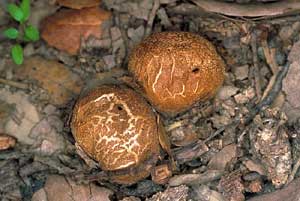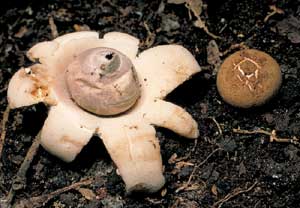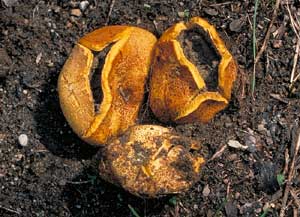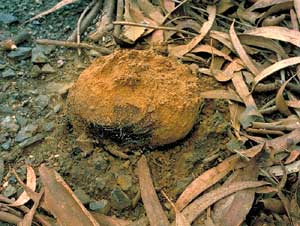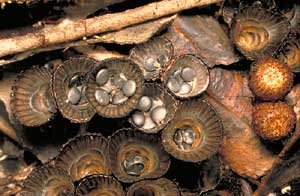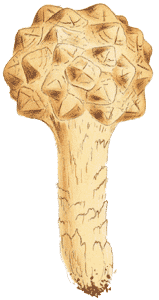
Types of fungal fruiting bodies (or sporocarps)
Stinkhorns, puffballs & birds nest fungi
Stinkhorns come in various shapes but all contain a khaki to brownish
slime. The unforgettable feature common to all stinkhorns is that they smell
of faeces or rotting meat when they first appear. A couple of examples are Anthurus
archerii ![]() and Dictyophora multicolor
and Dictyophora multicolor ![]() . Pier Antonio Micheli (1679-1737) included two pages of excellent, detailed stinkhorn drawings in his book Nova plantarum genera, which was published in 1729. He discussed two genera. One was the cage-like Clathrus and this link
. Pier Antonio Micheli (1679-1737) included two pages of excellent, detailed stinkhorn drawings in his book Nova plantarum genera, which was published in 1729. He discussed two genera. One was the cage-like Clathrus and this link ![]() will take you to a PDF that includes Micheli's drawings. The other genus was Phallus, and you can see a PDF with Micheli's drawings if you follow this link
will take you to a PDF that includes Micheli's drawings. The other genus was Phallus, and you can see a PDF with Micheli's drawings if you follow this link ![]() . The first published illustration of Clathrus appeared in Conrad Gessner's Historiae animalium of 1558, where the definitely terrestrial Clathrus was mistakenly treated as a marine organism. This link
. The first published illustration of Clathrus appeared in Conrad Gessner's Historiae animalium of 1558, where the definitely terrestrial Clathrus was mistakenly treated as a marine organism. This link ![]() will take you to a PDF with that illustration.
will take you to a PDF with that illustration.
Puffballs and and the like. The feature common to all of these is that,
at maturity, the bulk of the fruiting body consists of powdery spores. Mature
puffballs are simply bags of spores, with the bag being somewhat elastic. At
the top of the bag is a small opening. Puffballs are no more than a few centimetres
in diameter. Bovista is a common puffball genus.
Related to puffballs are the earthstars which look like puffballs on star-like
bases. In all earthstars the spore bags are no more than a few centimetres in
diameter, with the majority of species having diameters under 2 centimetres.
Virtually all earthstars are in the genus Geastrum. Pier Antonio Micheli (1679-1737) included a page of superb earthstar drawings in his book Nova plantarum genera, which was published in 1729. This link ![]() takes you a PDF which includes that page of earthstar illustrations.
takes you a PDF which includes that page of earthstar illustrations.
Calostoma fuscum ![]() has a globe of spores on top of a braided, rubbery stem.
has a globe of spores on top of a braided, rubbery stem.
In other genera, such as Calvatia ![]() ,
Scleroderma and Pisolithus, the outer skin of the fruiting body is
tough or brittle, rather than elastic as in a puffball such as Bovista.
As you can see from the photo, the skin of Scleroderma is exceptionally
thick.
,
Scleroderma and Pisolithus, the outer skin of the fruiting body is
tough or brittle, rather than elastic as in a puffball such as Bovista.
As you can see from the photo, the skin of Scleroderma is exceptionally
thick.
See also GIANT PUFFBALL
Birds-nest fungi are small, steep-sided cups (up to a centimetre across
and of similar height) which contain small disk-like objects, giving the appearance
of eggs in a nest. The cups are generally creamy to grey to light brown and
are distinct from the cup-fungi mentioned above. Cyathus stercoreus ![]() is common on dung and organically rich soils while Cyathus novae-zealandiae
grows on well-rotted wood debris.
is common on dung and organically rich soils while Cyathus novae-zealandiae
grows on well-rotted wood debris.
Cannonball fungi – whereas the fruiting bodies of Birds Nest Fungi
are steep sided cups, the cup of the Cannonball Fungus (Sphaerobolus
stellatus) is shallow and only about 2mm across. Each cup contains only
one 'egg' or 'cannonball'. When immature the whole fruiting body is a closed
sphere. In this photograph ![]() you can see a line of immature fruiting bodies, going right (and slightly upward)
from the centre of the photo.
you can see a line of immature fruiting bodies, going right (and slightly upward)
from the centre of the photo.
See BIRDS NEST
& CANNONBALL FUNGI
![An Australian Government Initiative [logo]](/images/austgovt_brown_90px.gif)


